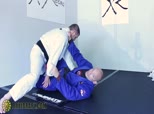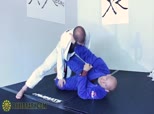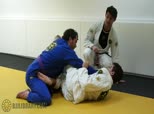Xande's Jiu Jitsu Fundamentals 35 - Protecting the Inside from Classic Guard
Add to Favorites Remove From Favorites 611 1023 days ago
Xande covers the importance of protecting the inside from the classic guard, which is essentially preventing your opponent from controlling your hip with his knee and forcing the half guard. In the case his opponent is able to force the half, Xande shows how to use your elbow and hand to regain the inside, insert the shield and recover guard.
Xande's Jiu Jitsu Fundamentals 34 - Threatening the Neck and Avoiding the Leg Smash Pass from Classic Guard
Add to Favorites 600 Remove From Favorites 1024 days ago
Xande covers another way to maintain his classic guard by threatening his opponent's neck whenever he begins to apply pressure on Xande. If he doesn't get the choke, he can retain his guard. If his opponent is strong enough to smash his legs, Xande becomes elegant and posts on his forearm so he can turn his body down and pull his leg free to recover guard.Xande's Jiu Jitsu Fundamentals 33 - Maintaining Classic Guard with Knee Shield
Add to Favorites 493 Remove From Favorites 1025 days ago
Xande covers the basics of maintaining his classic collar and sleeve guard, whether his opponent stands up to back away or kneels down to apply pressure. Xande uses his knee shield to create space, and his foot on the hip or pedal to create leverage. Another concept he comes back to is using the archer pose, when he pulls the sleeve up high, to create space to establish his pedal.Xande's Jiu Jitsu Fundamentals 5 - Protecting the Inside to Facilitate Knee Shield Insertion
Add to Favorites 560 Remove From Favorites 1094 days ago
Now Xande covers how to insert his knee shield and how protecting the inside helps facilitate it. From half guard he first protects the inside by bringing his elbow to his hip, inside his opponent's leg. This movement puts him on his side and gives him the leverage to push his opponent and insert his knee shield.Xande's Jiu Jitsu Fundamentals 3 - Protecting the Inside and Defending the Forced Half Guard
Add to Favorites 591 Remove From Favorites 1096 days ago
n this series Xande covers what he calls protecting the inside, which is his concept of defending from the bottom in half guard, mount, side control, etc., by wedging his elbow between his hip and his opponent. First in half guard, he shows his Landmark 2 position, which is staying on his side and bringing his elbow to his hip. Ultimately Xande will look to get to Landmark 3, which is his knee between his hip and elbow. While protecting the inside, it is crucial he stays on his side and does not allow his opponent to flatten him. After establishing Landmark 3, he can work his hip switch to recover his guard.Xande's Jiu Jitsu Fundamentals 2 - Understanding Landmarks One (Ribs), Two (Hips) and Three (Knees)
Add to Favorites 568 Remove From Favorites 1098 days ago
Xande explains what he calls landmarks one, two and three, which are your ribs, hips and knees, and how he applies this concept to his Jiu Jitsu. During the fight, especially while defending, he will always be either protecting his landmarks or looking to connect them. These concepts will become more clear as the lesson progresses.Inside the University 1035 - Curu Curu Guard Setup and Basics
Add to Favorites 541 Remove From Favorites 1191 days ago
To begin this lesson on the Curu Curu guard, Gustavo goes over the proper set up and covers a few different grip variations and off balances, before diving into the sweeps.Inside the University 1015 - Preventing the Guard Pass while Sitting Down
Add to Favorites 77 Remove From Favorites 1246 days ago
Nick answers some students' questions on how to prevent the guard pass while sitting down, and goes into the importance of not letting your opponent control your legs or pants to set up his guard pass.Inside the University 998 - Refining the Stack Pass Recovery Drill
Add to Favorites 517 Remove From Favorites 1269 days ago
Nick corrects some mistakes his students are making on the drill and answers questions on how to perform the movement properly. He also explains how to incorporate the drill into an actual training scenario.Inside the University 997 - Stack Pass Guard Recovery Drill
Add to Favorites 581 Remove From Favorites 1270 days ago
Now for another guard recovery drill, Nick has one knee between him and his opponent, and his opponent is swimming his arm under the other leg to stack and pass. Nick shows how he can push his opponent's elbow to gain better leverage with his leg and turn his hips to recover his guard.Inside the University 996 - Feet on the Hips Guard Retention Drill
Add to Favorites 511 Remove From Favorites 1271 days ago
To start the lesson, Professor Nick Schrock shows a guard retention drill to work on keeping your opponent in front of you. While on your back, your opponent steps around to the side. Your outside foot comes up to his hip and you use him as leverage to square yourself up to him. He moves to the other side and you repeat.Inside the University 984 - Protecting with Your Elbow
Add to Favorites 552 Remove From Favorites 1311 days ago
Saulo covers some details on preventing the pass, focusing on the importance of protecting yourself with your top elbow. While your bottom elbow stays tucked to your body, your top elbow stays pointed up with your arm out keeping separation between your body and your opponent's body.











